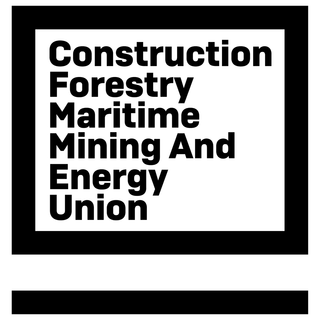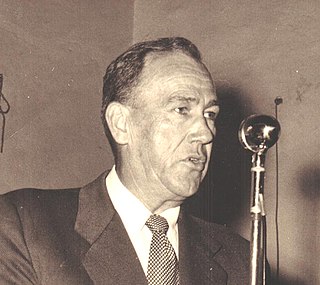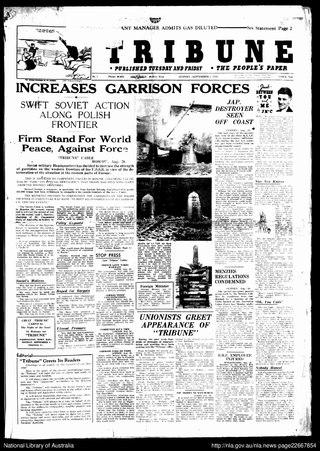Related Research Articles
The Labor Right, also known as Modern Labor or Labor Unity, is a political faction of the Australian Labor Party (ALP) at the national level that is characterised by being more economically liberal and, in some cases, more socially conservative. The Labor Right is a broad alliance of various state factions and competes with the Labor Left faction.
The Australian Workers' Union (AWU) is one of Australia's largest and oldest trade unions. It traces its origins to unions founded in the pastoral and mining industries in the late 1880s and it currently has approximately 80,000 members. It has exercised an outsized influence on the Australian Trade Union movement and on the Australian Labor Party throughout its history.

The Construction, Forestry, Maritime, Mining and Energy Union is Australia's main trade union in construction, forestry, maritime, mining, energy, textile, clothing and footwear production. The CFMMEU is affiliated with the Australian Council of Trade Unions and the Australian Labor Party.

John James McNeill was an Australian politician and trade unionist. He was a member of the Australian Labor Party (ALP) and served two terms in the House of Representatives, representing the Division of Wannon in Victoria. He was Minister for Health and Minister for Repatriation from 1931 to 1932, holding office in the government of his brother-in-law James Scullin.

Harold George "H. G." Nelson was an Australian politician and trade unionist who was the first person to represent the Northern Territory in the House of Representatives. He arrived in the territory in 1914 to work as an organiser for the Australian Workers' Union (AWU), and was a leader of the Darwin rebellion of 1918. He subsequently served in the House of Representatives from 1922 to 1934, initially as an independent and then as a member of the Labor Party.

Edward Grayndler was an Australian trade unionist and politician. He served as general secretary of the Australian Workers' Union (AWU) from 1912 to 1941, the longest term in the union's history.
Manufacturing Grocers' Employees' Federation of Australia (M.G.U.) was an Australian trade union existing between 1906 and 1988. The union was first established as the Federated Candle, Soap, Soda & Starch Employees' Union of Australia, before changing its name in 1914. The union represented workers employed in manufacturing grocers' sundries and non-edible grocery products, particularly in the southern states of South Australia and Victoria. In 1988 the union amalgamated with the Federated Millers and Mill Employees' Union to form the Federated Millers and Manufacturing Grocers Employees' Association of Australia, which in turn merged with a number of unions to form the National Union of Workers.

Donald Macdonell was a politician, trade unionist and shearer in New South Wales, Australia.
The Australasian Institute of Mining and Metallurgy (AusIMM) provides services to professionals engaged in all facets of the global minerals sector and is based in Carlton, Victoria, Australia.

The Federated Ironworkers' Association of Australia (FIA) was an Australian trade union which existed between 1911 and 1991. It represented labourers and semi-skilled workers employed in the steel industry and ironworking, and later also the chemical industry.

Tom Nicholson Pearce Dougherty, was an Australian trade union official and a member of the New South Wales Legislative Council. As National Secretary of the Australian Workers Union (AWU) from 1944 to 1972, he was one of the most powerful figures in the Australian labor movement and the Labor Party.

Tribune was the official newspaper of the Communist Party of Australia. It was published by the Central Committee of the Communist Party of Australia from 1939 to 1991. Initially it was subtitled as Tribune: The People's Paper. It was also published as the Qld Guardian, Guardian (Melbourne), Forward (Sydney). It had previously been published as The Australian Communist, (1920-1921) The Communist, (1921-1923) and the Workers' Weekly (1923-1939).

George Sangster was a Scottish-born Australian politician. He was a member of the Victorian Legislative Assembly from 1894 until his death in 1915, representing the electorate of Port Melbourne for the Australian Labor Party (1894-1902), as an Independent Labor member (1902-1905) and again as an endorsed Labor member (1905-1915).
The National Union of Rail Workers of Australia (NUR) was an Australian trade union representing railway industry workers which operated from 1938 until 1993.
The Australian Transport Officers' Federation (ATOF) was an Australian trade union representing salaried officers in the transport sector, particularly in the rail and airline industries. It existed from 1924 until 1991, and was previously known as the Federation of Salaried Officers of Railways Commissioners (1924–1947) and the Australasian Transport Officers Federation (1947–1978). The union had a policy of supporting conciliation and arbitration and against strike action until 1970.
The Building Workers' Industrial Union of Australia was an Australian trade union covering workers in the construction industry.
The Lieutenant-Governor of Victoria is a government position in the state of Victoria, Australia, acting as a deputy to the Governor of Victoria. When the governor is out of the state, the lieutenant-governor acts as the governor. This office has often been held concurrently by the Chief Justice of Victoria.
Sir Herbert William Gepp was an Australian industrial chemist, businessman and public servant.
Russell Mervyn Murray, commonly referred to as R. M. Murray, was general manager of the Mount Lyell Mining and Railway Co. Ltd, Queenstown, Tasmania for 22 years. Unusually for a mining man, his entire career of 44 years was spent at one location and for one company.
Trading as Norske Skog Boyer, the Boyer Mill is a pulp and paper mill located in Boyer, Tasmania, Australia. Constructed in 1941 by Australian Newsprint Mills, the mill was the first producer of newsprint paper in Australasia. Producing 260,000 tonnes of product in 2020, the mill is currently Australia's only manufacturer of newsprint and magazine-grade paper. The mill's operations make a substantial contribution to Tasmania's gross state product, estimated at $390 million. Boyer Mill has been owned and operated by the Norwegian pulp and paper company Norske Skog since 2000.
References
- 1 2 3 4 5 6 7 Huntley, Pat (1980). Inside Australia's Top 100 Unions. Middle Cove, NSW: Ian Huntley (Aust.). ISBN 0-9598507-4-0 . Retrieved 16 July 2018.
- 1 2 "Pulp & Paper Workers Federation of Australia (1948 - 1991)". Australian Trade Union Archives. Retrieved 12 May 2018.
- ↑ "Paper Mill Employes' Union". The Age . No. 16998. Victoria, Australia. 6 September 1909. p. 8. Retrieved 12 May 2018– via National Library of Australia.
- ↑ "Industrial News". The Argus (Melbourne) . No. 20, 918. Victoria, Australia. 9 August 1913. p. 21. Retrieved 12 May 2018– via National Library of Australia.
- ↑ "Paper Mill Employes". The Age . No. 19, 114. Victoria, Australia. 26 June 1916. p. 8. Retrieved 12 May 2018– via National Library of Australia.
- ↑ "Paper Duties". Warrnambool Standard . No. 10, 712. Victoria, Australia. 12 February 1914. p. 3 (DAILY.). Retrieved 12 May 2018– via National Library of Australia.
- ↑ "Deputations to Minister". The Daily Telegraph . No. 13, 134. New South Wales, Australia. 15 June 1921. p. 9. Retrieved 12 May 2018– via National Library of Australia.
- ↑ "Brighton Gas Co". The Age . No. 26, 929. Victoria, Australia. 8 August 1941. p. 5. Retrieved 12 May 2018– via National Library of Australia.
- ↑ "Paper Mill Employees". The Argus (Melbourne) . No. 24, 442. Victoria, Australia. 8 December 1924. p. 15. Retrieved 12 May 2018– via National Library of Australia.
- ↑ "N.S.W. Paper Milling Industry". The Australian Worker . Vol. 53, no. 41. New South Wales, Australia. 11 October 1944. p. 9. Retrieved 12 May 2018– via National Library of Australia.
- ↑ "Sick Leave Only for AWU Members". The Telegraph . Queensland, Australia. 8 February 1943. p. 6 (City Final Last Minute News). Retrieved 12 May 2018– via National Library of Australia.
- ↑ "200 Strikers at Paper Mill". Daily Examiner . Vol. 33, no. 8127. New South Wales, Australia. 24 March 1943. p. 1. Retrieved 12 May 2018– via National Library of Australia.
- ↑ "Interloping Victorian Union Rebuffed". The Australian Worker . Vol. 52, no. 12. New South Wales, Australia. 24 March 1943. p. 5. Retrieved 12 May 2018– via National Library of Australia.
- ↑ "Rival Unions' Dispute". The Mail (Adelaide) . Vol. 31, no. 1, 610. South Australia. 3 April 1943. p. 12. Retrieved 12 May 2018– via National Library of Australia.
- ↑ "Strike for Right to Organise". Newcastle Morning Herald and Miners' Advocate . No. 20, 749. New South Wales, Australia. 8 April 1943. p. 4. Retrieved 12 May 2018– via National Library of Australia.
- ↑ "Union Fight at Mill". Sydney Morning Herald . No. 32, 852. New South Wales, Australia. 12 April 1943. p. 7. Retrieved 12 May 2018– via National Library of Australia.
- ↑ "Paper Mill Union Restricted". The Canberra Times . Vol. 17, no. 4727. Australian Capital Territory, Australia. 12 May 1943. p. 3. Retrieved 12 May 2018– via National Library of Australia.
- ↑ "Order to Restrain is Refused". The Newcastle Sun . No. 8058. New South Wales, Australia. 21 October 1943. p. 3. Retrieved 12 May 2018– via National Library of Australia.
- 1 2 "Printers' Pie". Westralian Worker . No. 2088. Western Australia. 19 November 1948. p. 7. Retrieved 12 May 2018– via National Library of Australia.
- ↑ "Call to Labor Ms. P." The Australian Worker . Vol. 59, no. 15. New South Wales, Australia. 12 April 1950. p. 1. Retrieved 12 May 2018– via National Library of Australia.
- ↑ "Counsel Sees Reds as Threat to AWU". The Sun . No. 12, 671. New South Wales, Australia. 7 September 1950. p. 15 (Late Final Extra). Retrieved 12 May 2018– via National Library of Australia.
- ↑ "Unions Fight Over Members". Barrier Daily Truth . Vol. XLII, no. 13, 264. New South Wales, Australia. 8 September 1950. p. 5. Retrieved 12 May 2018– via National Library of Australia.
- ↑ "Union Dispute". The Advertiser (Adelaide) . Vol. 95, no. 29, 436. South Australia. 14 February 1953. p. 3. Retrieved 12 May 2018– via National Library of Australia.
- ↑ "A.C.T.U. Warns Papermakers on Tasmanian 'Encroachment'". The Advocate (Australia) . Tasmania, Australia. 14 March 1953. p. 7. Retrieved 12 May 2018– via National Library of Australia.